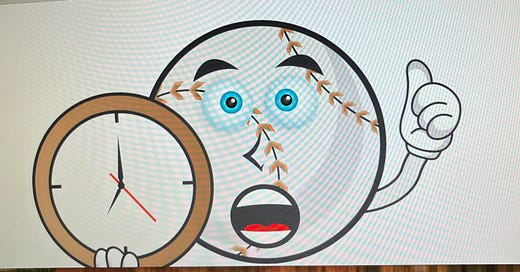‘Time’s Up!’ Rabbis will be serving up their homiletical offerings at a faster pace this Rosh Hashanah.
Good news for current and potential synagogue attendees who complain that Shabbat and holiday services are too long.
Following the lead this season of Major League Baseball, which streamlined some long standing rules to increase fan attendance by speeding up the game, a group representing all denominations of the Jewish faith has announced a number of modifications that will shorten services significantly, starting this High Holy Day season.
In the most dramatic change, according to Rav Reuven (Rob) Manfred, commissioner of the newly formed Council of Major Rabbinic Groups, “sermons will be limited to 13 minutes, starting with the rabbis’ typical opening line, ‘A few words before I begin,’ and ending with, ‘And let us say, Amen.’”
Rabbis will be able to pause up to 15 seconds twice during the delivery of the sermon to clear their throats or sip a glass of water (except on Yom Kippur).
To ensure that the change is effective, a large Sermon Clock will be placed on the Ark, in a highly visible spot behind the rabbi’s lectern, and will count down the allotted minutes and seconds. When time runs out, a red blinking light will flash in three stages.
For 15 seconds it will flash: “YASHER KOACH” (Well Done).
If the rabbi has not completed the sermon by that point, for 15 seconds it will flash: “THE SERVICE CONTINUES ON PAGE 322”.
And if the rabbi is still speaking at that point, the clock will flash, and a loud recording will say: “YOUR SERMON – AND CONTRACT – ARE OVER.”
“We believe that those messages, subtle as they are, will do the trick,” Rav Manfred told a crowded press conference at the prominent Upper East Side synagogue, Congregation Ahavat Kesef.
He chose not to comment on a report that some congregational leaders are calling for a more radical element, known as the Korach Kabash (KK), to be added to the Sermon Clock. The KK would go into effect if the previous flashing messages are ignored. At that point a trap door would open under the rabbi’s lectern and the rabbi would disappear.
“We’ll see how things work out in our Junior Congregation services this summer,” Rav Manfred said, “and make our final decisions before Rosh Hashanah.”
In addition to the Sermon Clock, the new council has voted to eliminate handshakes between clergy and congregants – and among congregants – during services, such as after an aliyah, opening and closing the ark, etc. Conservative estimates are that this will reduce the time of services by at least 22 minutes. (Orthodox and Reform estimates are about the same.)
Among other changes:
. The Bimah, or platform from which the Torah is read, will be extended six inches on each side to make access a bit faster;
. Congregants will be advised to reduce “shuckling” (swaying back and forth) during prayers so as to prevent motion sickness among some members;
. To save time, congregants will be asked to take two steps back on completing the Amidah rather than three.
“Every little bit helps,” said Rav Manfred.
As for the prayers themselves, each of the denominations has elected to make its own changes. For example, some traditional congregations will reduce the weekly Torah portions to eight sentences a week so that the reading of the Five Books of Moses will take approximately 11 years.
More progressive congregations will now read from The Three-and-a-Half Books of Moses.
Very liberal congregations will meet only online and use their houses of worship exclusively for Bingo.
In chasidic services, niggunim (wordless melodies) will be limited to three “eidel deidel” verses instead of the usual 22.
Some extremely observant congregations are divided over whether to skip the second “Y’kum purkon” prayer at the beginning of Musaf on Shabbat morning or replace the Haftorah reading with the Kiddush Club.
“We all have our differences,” Rav Manfred noted, “but our first concern is to provide a respectful and pleasant service that will attract worshippers. We want synagogue attendance to resume its status as our national pastime – instead of ‘past time.’”





A cute idea, applying MLB’s time tightening changes (dare I call them “reforms”?) to services.
It was with a similar goal, but in a more sober spirit, that Mordecai Kaplan omitted the repetition of the Amidah in the 1930s/40s.
Moving for inspiration from MLB to music (but with tongue still firmly in cheek), I suggest saving time and retaining attention by chanting the Torah and Haftarah portions in parallel instead of in sequence. My inspiration is “dueling banjos.”
How will it work? We add a second reader’s stand. Between aliyot--during the lulls when the leyning pauses for people to rise to and descend from the bimah, the word in the scroll with which to begin chanting is identified with the yad, tzitzit are pressed to that point to be kissed, etc.--someone at the second stand chants several verses of the Haftarah portion, then pause for the person with the next Aliyah to say the bracha.
Tightly interleaving the chanting of two scriptural texts not only makes for a more concise service; it also emphasizes the intertextuality of the Torah service, in which the Haftarah portion was originally chosen as a comment on some aspect of the Torah portion.
For those who haven’t seen it, here’s the dueling banjos scene from the movie Deliverance:
https://youtu.be/myhnAZFR1po
Your article about speeding up services was cute, but the suggestion to take only two steps back instead of three before the Amidah had me laughing outloud. ... I'm still laughing.
Thanks